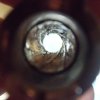I was loading Dardas 125 gr RN 9mm in .357" for my Ruger SR9C with 4.3 gr Unique and I never experienced ANY leading problems. I probably shot 1500 of those and never noticed any lead in the barrel, in fact I wondered if I was missing it because I didn't know what to look for.
I switched to W231 when my Unique got too smokey and bulky for my preferences. Now loading the same bullets for the same gun with 4.3 gr of W231 and after about 150 of those I have lead in the barrel...
So, what causes the leading in my barrel?
I switched to W231 when my Unique got too smokey and bulky for my preferences. Now loading the same bullets for the same gun with 4.3 gr of W231 and after about 150 of those I have lead in the barrel...
So, what causes the leading in my barrel?





